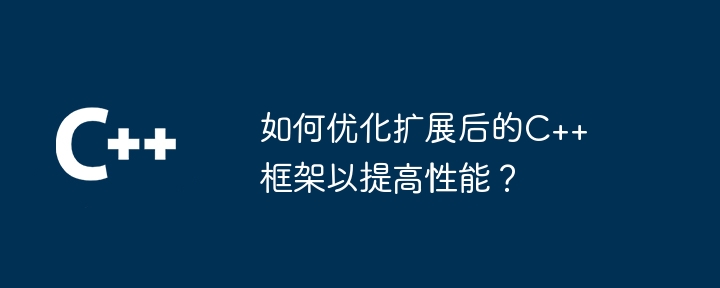在扩展 c++++ 框架时,优化至关重要。技巧包括:1. 剖析性能瓶颈;2. 微优化(避免不必要拷贝、优化内存对齐、内联关键函数);3. 并发编程(使用多线程、原子数据结构);4. 缓存(使用 cpu 缓存、函数内联);5. 代码生成(使用编译器优化、jit 编译);6. 减少内存开销(避免不必要分配、使用轻量级容器)。

如何优化扩展后的 C++ 框架以提高性能
当扩展 C++ 框架时,优化是保持高性能的关键。以下是一些经过实战验证的技巧:
1. 剖析性能瓶颈
立即学习“C++免费学习笔记(深入)”;
代码实战:
#include <gprof.h>
int main() {
gprof_here();
// ... 代码 ...
return 0;
}2. 微优化
代码实战:
struct MyStruct {
int x;
char name[256];
} __attribute__((packed)); // 强制对齐3. 并发编程
代码实战:
#include <atomic>
std::atomic_int counter;
int main() {
std::thread t1([&] { counter++; });
std::thread t2([&] { counter++; });
t1.join();
t2.join();
std::cout << counter << std::endl; // 输出 2
return 0;
}4. 缓存
代码实战:
int sum_array(int* arr, int len) {
int sum = 0;
for (int i = 0; i < len; i++) {
sum += arr[i];
}
return sum;
}5. 代码生成
代码实战:
// 启用编译器优化
int main() {
return 0;
}6. 减少内存开销
代码实战:
// 使用对象池
struct MyObject {
int data;
};
class ObjectPool {
public:
static MyObject* get() {
if (objects.empty()) {
return new MyObject();
}
auto obj = objects.back();
objects.pop_back();
return obj;
}
static void recycle(MyObject* obj) {
objects.push_back(obj);
}
private:
static std::vector<MyObject*> objects;
};
int main() {
auto obj1 = ObjectPool::get();
// ... 使用 obj1 ...
ObjectPool::recycle(obj1);
return 0;
}以上就是如何优化扩展后的C++框架以提高性能?的详细内容,更多请关注php中文网其它相关文章!

Copyright 2014-2025 https://www.php.cn/ All Rights Reserved | php.cn | 湘ICP备2023035733号